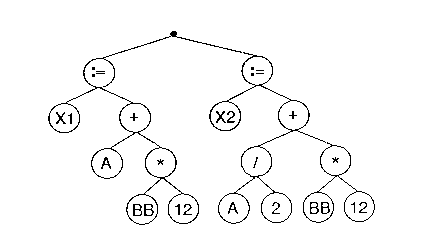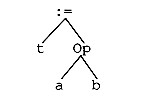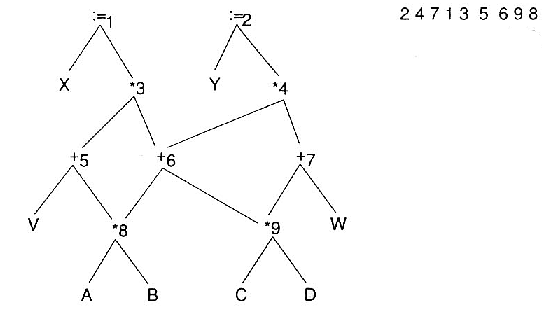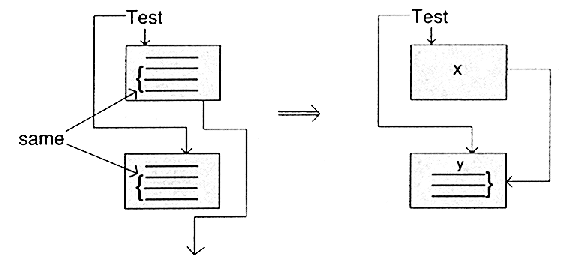
11.0 Introduction
The preparation for code generation phase decides how to allocate registers and memory. Thhe code generation phase translates the intermediate representation to assembly language using these registers and memory assignments.
Various methods have been developed for good use of registers. One technique is to store all loop variables in registers (until there are no more registers) since statements inside loops may execute more than once.
Another easily implemented technique is to store the variables used the most in registers.
For machines with a stack and a stack pointer, operations involving the stack are generally quicker than those involving an access to (non-stack) memory. Thus, another code generation technique is to push all variables in a procedure onto the stack before the procedure is executed, access them from the stack (and two registers).
Careful assignment of expressions and variables to registers can increase the efficiency of the resulting compiler. In this module, we will generate code as though there were only one available register.
Example 1 shows directives for integers for a number of machines.
Example 1 Directives from a symbol table entry for a name with class = variable, type = integer, and character string A
On an 86-family: A DW ?
On a M68000: A DS.L
Consider the following abstract syntax tree for the two assignment statements:
X1 := A + BB * 12;
X2 := A/2 + BB * 12;
from Module 1:

Using a tree walk which generates code for the subtrees first, then applies the parent operator, the following code can be easily produced:
Load BB, R1
Mult #12, R1
Store R1, Temp1
Load A, R1
Add Temp1, R1
Store R1, Temp2
Load Temp2, R1
Store R1, X1
Load A, R1
Div R1, #2
Store R1, Temp3
Load BB, R1
Mult #12, R1
Store T4, R1
Load T3, R1
Add T4, R1
Store T5, R1
Load T5,R1
Store R1,X1
For two leaf nodes, the method shown loads the left-most into a register. The right-most leaf node could just as well have been the one put into the register.
Exercise 3 asks the reader to write the algorithm for this method.
Notice that the code continually stores the value in the register into memory in order to reuse it for the next computation. This is called a register spill.
The example in this section generates code for assignment statements whose right-hand sides are expressions. The next section discusses code generation strategies for various other language constructs.
A tree pattern of the form:

generates a Move instruction:
where aPlace represents the register, stack position or
memory location assigned to a.
MOVE aPlace,T
Suppose Op represents an arithmetic operation and consider an abstract syntax tree for the statement t = a Op b:

One possible code sequence is:
MOVE aPlace,Reg
OP bPlace,Reg
MOVE Reg,T
This is the method used in the example of the previous section. Of course, some machines require that special registers be used for operations such as multiplication and division.
IF statements can be represented by an abstract syntax tree such as:

A typical code sequence is:
(Code for condition)
BRANCHIFFALSE Label1
(Code for Statements1)
BRANCH Label2
Label1: (Code for Statements2)
Label2:
Example 3 illustrates this for the statement:
IF a < b THEN Max = b ELSE Max = a;
In Example 3, aPlace and bPlace mey refer to the variables a and b themselves, if the machine allows two memory operands. For machines such as the 86-family (PC-clones) which require that one operand be in a register, the instruction:
COMPARE aPlace,bPlace
MOVE Reg,aPlace
CMP Reg,bPlace
if neither a nor b have been previously assigned to a register.
Loops are just conditionals whose code is repeated. Consider the loop:
LOOP While condition DO
Statements
ENDLOOP
An abstract syntax tree is:

A reasonable code sequence is:
Label1: (Code for NOT condition)
BRANCHIFTRUE Label2
(Code for Statements)
BRANCH Label1
Label2:
Example 4 shows such a loop:
Memory allocation techniques are discussed in Module 12; in this chapter, we will address the issue of register allocation.
Some compilers make a tentative allocation, then try an assignment, and if necessary reallocate.
There are two general approaches to register allocation. The first divides the registers to be allocated into two classes. The first class is those globally allocated: those to be allocated for the whole program or for a whole subprogram or perhaps a loop, and the second class is those used for temporary values and computations within a straight-line (no branches from IF's or loops) sequence of code.
The second method is to do all allocation on a global basis, without dividing the registers into two classes.
Simple global register allocation allocates registers for variables in inner loops first since that is generally where a program spends a lot of its time. Of course, this same register should be used for the variables if it also appears in an outer loop. After registers have been allocated globally, at least one (and often more) register is kept free for holding temporary results.
Example 5
Consider the following loop:
Here, there are five references to X,
and Z, five references to Y, three references
to D, and one to E. Thus, if there are three
registers, a reasonable approach would be to allocate X
and Z to two of them, saving the third for local
computations. The resulting code would be (something like):
LOOP: X = 2 * E
Z = Y + X + 1
IF some condition THEN
Y = Z + Y
D = Y - 1
ELSE Z = X - Y
D = 2
ENDIF
X = Z + D
Z = X
ENDLOOP
Load X,R1
Load Z,R2
Loop: Load E,R3
Mult #2,R3
Store R3,X
Copy R1,R3
Add Y,R3
Add #1,R3
Store R3,Z
IF some condition THEN
Copy R2,R3
Add Y,R3
Store R3,Y
Load Y,R3
Sub #1,R3
Store R3,D
ELSE Copy R1,R3
Sub Y,R3
Store R3,Z
Load #2,R3
Store R3,D
ENDIF
Copy R2,R3
Add D,R3
Store R3,X
Store R3,Z
{ENDLoop}
 Using data flow of uses and definitions of variables, set up
use-def chains:
Using data flow of uses and definitions of variables, set up
use-def chains:
Link a def with all its uses to form a chain
 Two program quantities cannot share the same register if their
use-def chains overlap.
Two program quantities cannot share the same register if their
use-def chains overlap.
 Called Overlapping lifetimes
Called Overlapping lifetimes
Register Allocation by Coloring
For each program quantity to be allocated to a register,
Create A Node
Draw an arc between nodes whose lifetimes overlap
Colorgraph(n)
 Called an Interference Graph
Called an Interference Graph
 If n registers, and graph can be colored with n
colors, registers can be assigned.
If n registers, and graph can be colored with n
colors, registers can be assigned.
 An NP-Complete Problem
An NP-Complete Problem
 Register Allocation prioritizes which variables to be kept in registers
Register Allocation prioritizes which variables to be kept in registers
 Register Assignment (the other side) Which actual registers to use
Register Assignment (the other side) Which actual registers to use
 May depend on the machine
May depend on the machine
 Registers allocated and then freed
Registers allocated and then freed
 Register spill: when we remove a value
we'd really like to keep in a register, but can't
Register spill: when we remove a value
we'd really like to keep in a register, but can't
Stored value same
Variables and expressions not "live"
Heuristics
Belady's Algorithm adapted for Register Allocation
Create A Node
Else if there is an acceptable register, use it
Else use that register whose value won't be used for the longest
time (spill the value)
If the required value is already in a register, then leave it there.
 Lots of bookkeeping for overseeing registers. Useful info to keep:
Lots of bookkeeping for overseeing registers. Useful info to keep:
Future uses (usage counts)
Distance to next use
Copy in memory?
Copy in another register
Cost of recomputing contents
Most recent use
Past uses
Algorithm
Label (Expression Node)
1. Node is a left-most leaf: Label = 1
2. Node is a right-most leaf: Label = 0
3. (Otherwise)
3(a)Label (Left(Node)
3(b)Label (Right(Node)
3(c)Label# (Node) = Max(Left Label# , Right Label#)
or Left Label# + 1 if Left Label# = RightLabel#.
The algorithm is called with Label(root)Using the tree labelled as above, we can write an effiecient code generation algorithm:
Algorithm
GenerateCode (Node)
CASE Node is:
A leaf labeled 1 and a left leaf:
(a) R = GetReg
(b) Generate "Load Node, R"
Labeled with a number greater than available registers:
(a) Generate code for right child
(b) Store the result in a temp
(c) Generate code for the left child
(d) Apply node's operator to (a) and (c)
Has a right child that is a leaf:
(a) Evaluate the left child
(b) Apply node's operator to left child
result and leaf.
Otherwise:
(a) GenerateCode(Node with larger label). (Use either if
labels are the same) Leave result in a register
(b) GenerateCode (Other Node)
(c )Apply node's operation to registers holding
the two results.
To prepare the list of DAG nodes to compute (that is, the list for which code is to be emitted), start at the root of the right-most subtree. Put this node on the list, L, and continue by adding a left-most node to the list after all its parents are already on the list. Then generate code for the nodes in L by starting at the end of L and proceeding to the beginning.

Thus, we would put out code for node 8 first, then node 9, etc.
Another way to put out good code from DAG's is to break the DAG up into trees and to use a code generation algorithm which is optimal on trees. (Of course, it takes time to break up the DAG.)

LOAD A, Reg2
Just looking at the BRANCHes, we see:
64: BRANCH 66
66: BRANCH 142
91: BRANCH 93
93: BRANCH 121
121: BRANCH 142
142: BRANCH 50
66: BRANCH 50
91: BRANCH 50
93: BRANCH 50
121: BRANCH 50
142: BRANCH 50
Line Source
Output Code
50 WHILE a DO
50:
51 BEGIN
...
61 CASE i OF
62 0: IF b THEN
63 x:=1;
64 ELSE
64: BRANCH 66
65 x:=2;
66 {end case i=0}
66: BRANCH 142
67 l:
...
81 4: CASE j OF
...
89 2: IF b THEN
90 x:=0;
91 ELSE
91: BRANCH 93
92 x:=1;
93 {end case j=2}
93: BRANCH 121
...
120 end; {case j}
121 {end case i=4}
121: BRANCH 142
...
141 end; {case i}
142 end; {while a}
142: BRANCH 50
50:
If we fully eliminated the indirect jumps, it would look like this:
50:
64: BRANCH 50
IF Condition THEN
A[I]:=x+1
ELSE
A[I]:=y+1
The output code differs by only 1 load. We can perform that load and then execute the rest of the instructions: ADDing 1 and assigning to A[1]. This can be seen pictorially where test is the code for the condition:

In the right-most picture the identical code is written only once.
ADD #1, Reg2
INCREMENT Reg2
MOVE Reg2, A
ADD Reg1, Reg2
ADD Reg1, Reg2, A
A statement by statement code generator tends to produce poor code, where by "good" code we mean code that executes fast or takes up less space. To produce better code, code generation avoids extra computation, reusing computed values (common subexpressions) if reuse is less expensive than recomputing.
Further efficiency can be achieved by avoiding extra loads, unnecessary stores, avoidable register-to-register moves, and special instructions.
A good code generator design, like all software, is easier to implement, easier to test, and easier to maintain.